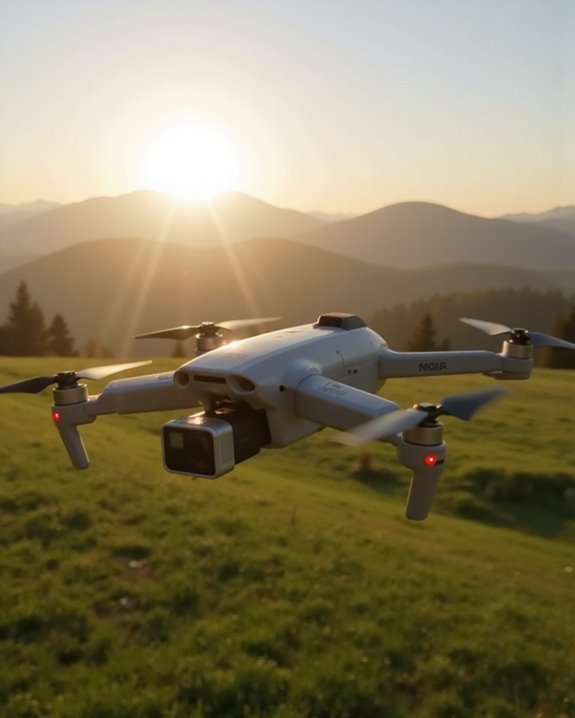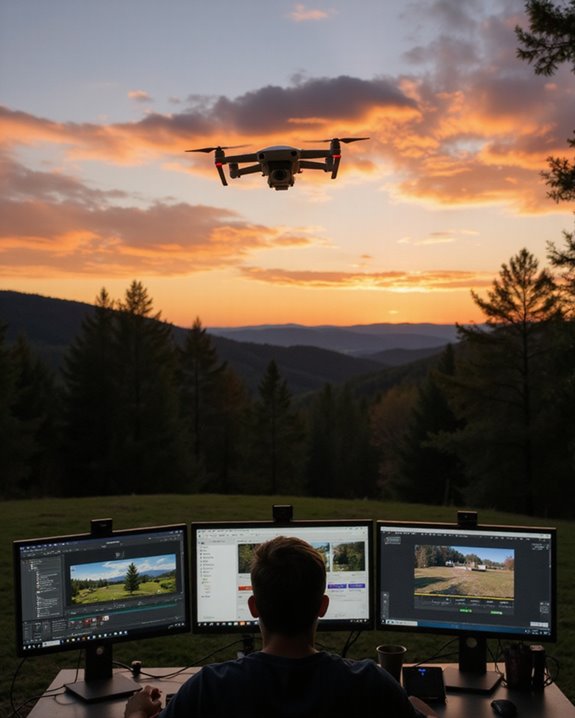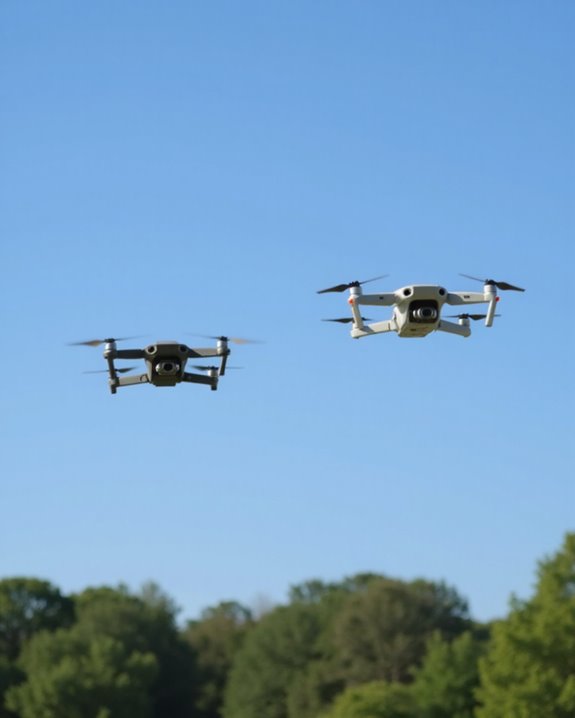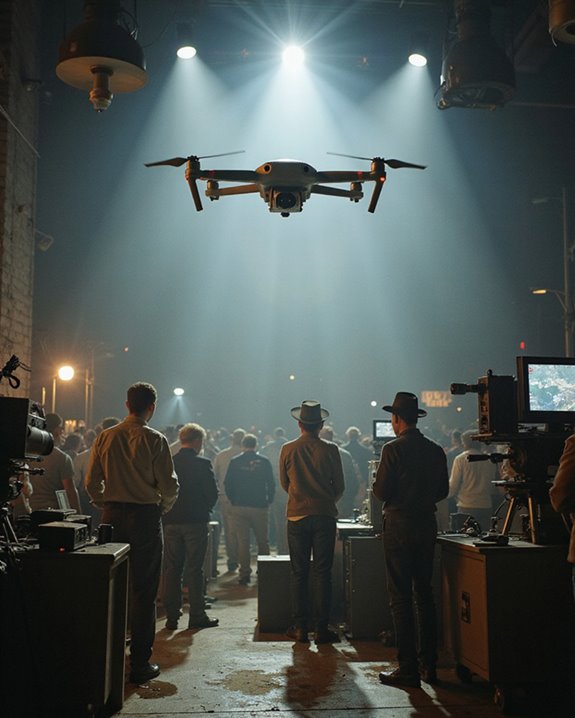GoPros can’t replace dedicated FPV cameras for piloting drones due to their significant latency. While FPV cameras deliver real-time video feedback in milliseconds, GoPros lag by several seconds—far too slow for split-second flight decisions! They work wonderfully as secondary cameras for capturing high-quality footage, though. The HERO10 Black Bones weighs just 54 grams, making it ideal for FPV setups. With proper mounting and settings adjustments, your aerial cinematography can reach professional heights without compromising flight performance.
Key Takeaways
- GoPros can be used as secondary cameras for recording, but their several-second latency makes them impractical for primary FPV flight control.
- Purpose-built FPV cameras deliver ultra-low latency video feeds essential for real-time piloting and split-second flight decisions.
- The GoPro HERO10 Black Bones weighs only 54 grams, making it ideal for lightweight FPV drone setups.
- HyperSmooth stabilization technology provides smooth footage during flips and rolls without requiring extensive post-processing.
- Optimal GoPro mounting requires lightweight solutions like TPU or 3D-printed custom mounts to minimize impact on flight performance.
Understanding FPV Drone Cameras and GoPro Compatibility
The world of FPV (First Person View) drone flying opens up an exhilarating perspective that puts pilots virtually in the cockpit of their aircraft. At the heart of this technology lies a critical distinction between FPV cameras and action cameras like GoPro.
FPV cameras are purpose-built for one mission: delivering ultra-low latency video feeds directly to your goggles. This instantaneous Signal Transmission is essential for making split-second flight decisions! GoPros, while exceptional at capturing stunning footage, simply weren’t designed with real-time piloting in mind.
The Latency Comparison tells the whole story—FPV cameras transmit video in milliseconds, while GoPros might lag by several seconds, making them impractical for primary flight control. Think of it like trying to drive while watching a delayed video of the road ahead—not exactly a recipe for success!
Additionally, FPV cameras like the Foxeer Razer Mini offer features such as ultra-low latency and separate OSD to enhance racing performance, which GoPros cannot match.
Weight Considerations for GoPro Mounting on FPV Drones
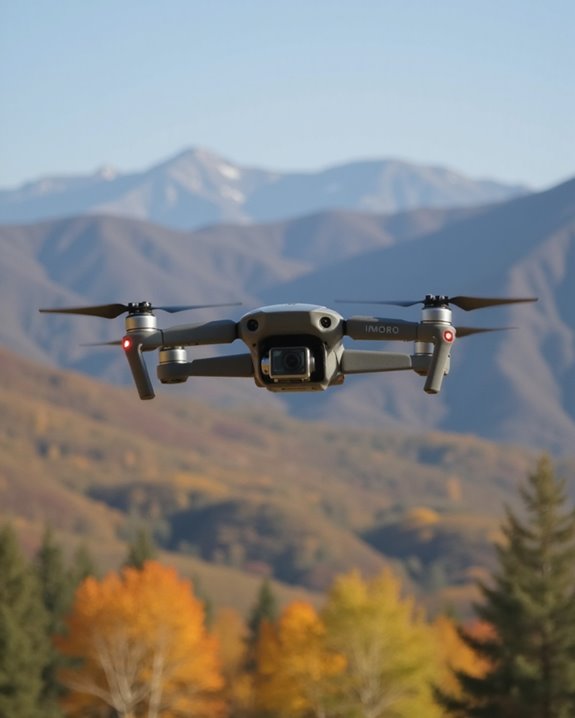
Weight management represents a pivotal consideration when mounting GoPro cameras on FPV drones, where every gram directly impacts flight performance. The HERO10 Black Bones weighs just 54 grams, making it an excellent choice for pilots obsessed with keeping their rigs light and nimble!
Traditional GoPro mounts add approximately 13 grams, while lightweight alternatives like the DJI FPV Drone GoPro Mount contribute about 18 grams. Smart pilots often opt for TPU or 3D-printed custom mounts to optimize Weight Distribution across the frame. These thoughtful mounting solutions minimize negative Aerodynamic Effects that could otherwise turn your smooth flying experience into a wobbly mess.
The magic happens when pilots balance quality capture against weight constraints. After all, what good is amazing stabilization if your drone handles like a flying brick?
Choosing drones with brushless motors can also enhance stability and reduce vibration, which is crucial when adding extra weight from cameras.
GoPro Models Best Suited for FPV Applications
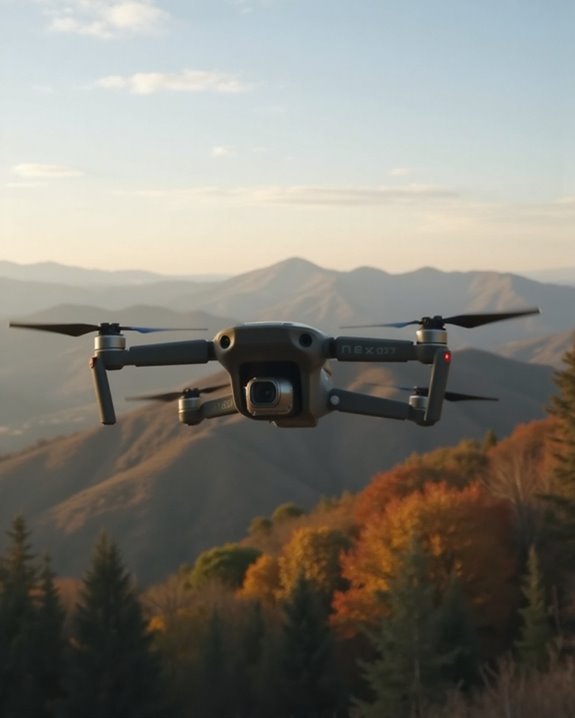
When selecting the perfect GoPro for your FPV adventures, which model delivers the ideal balance of weight, image quality, and features? Examining the Model History reveals impressive evolution through the Release Timeline of GoPro cameras designed for drone enthusiasts.
The Hero 10 Black Bones stands out as a game-changer, weighing under 60 grams—perfect for those lightweight builds! Meanwhile, the Hero 11 Black offers that versatile 8:7 aspect ratio that content creators absolutely love. For pilots seeking cutting-edge stabilization, the Hero 12 delivers HyperSmooth 5.0 with extended battery life, while the newer Hero 13 caters to post-production wizards with its flat log color profile. Each generation brings something special to the table, with the Bones specifically engineered for FPV applications where every gram counts!
For capturing the best footage during flights, pairing your GoPro with drones that offer high-quality video recording capabilities can significantly enhance your FPV experience.
Setting Up Your GoPro for Optimal FPV Performance
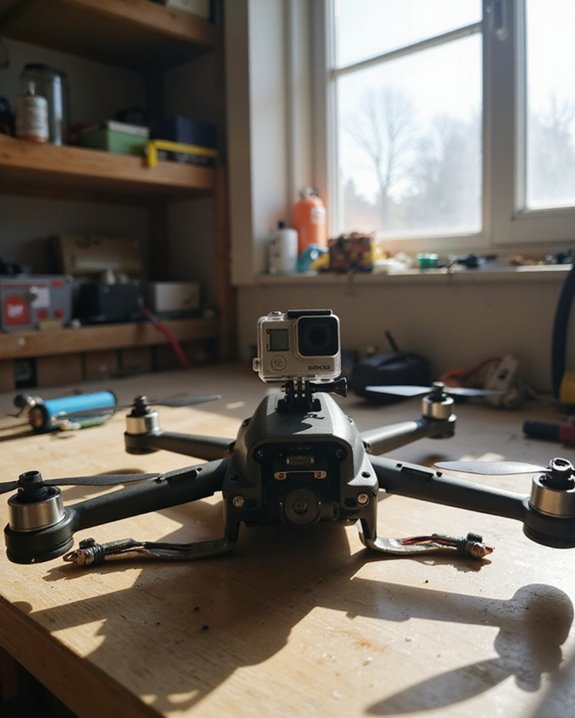
Setting up your GoPro for ideal FPV performance requires careful attention to detail, from mounting solutions to essential camera settings that make or break your aerial footage! Secure mounting is absolutely critical—a 3D printed mount will keep your camera stable while maintaining proper weight distribution on your drone.
For truly cinematic results, Firmware Optimization guarantees your GoPro captures at the perfect frame rate (60fps works wonders for smooth action), while adjusting shutter speed prevents that dreaded motion blur. Don’t forget about Lens Filters! These handy accessories can reduce glare and enhance colors for those jaw-dropping sunset flights.
Power management deserves special consideration too—nobody wants their perfect shot ruined by a dead battery! Connect your video transmitter properly, and you’ll be capturing breathtaking FPV footage that’ll make your friends wonder how you did it.
HyperSmooth and Stabilization Features for Drone Flight
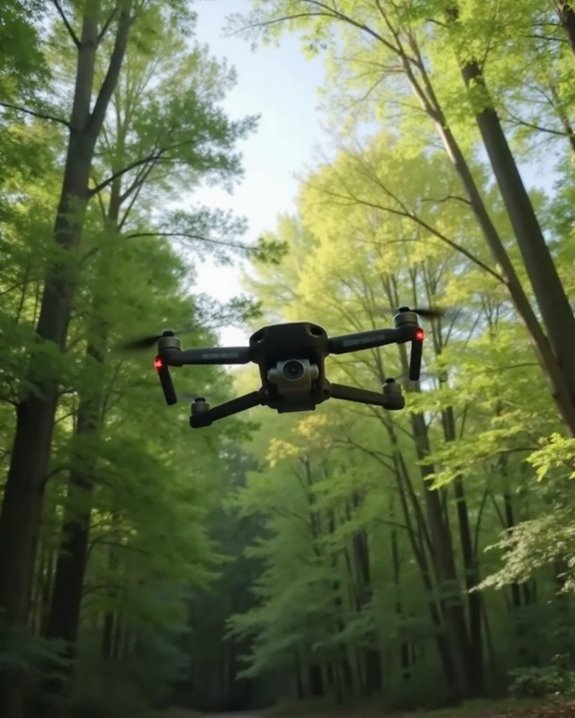
The revolutionary HyperSmooth technology stands as GoPro’s crown jewel for FPV drone pilots seeking buttery-smooth footage without the headache of post-processing! This digital stabilization marvel has evolved through multiple Algorithm Updates, with HyperSmooth 4.0 offering unprecedented stability even during those wild flips and rolls.
What makes HyperSmooth particularly impressive for drone enthusiasts is how it preserves intentional banking motions while eliminating unwanted jitters. The Sensor Calibration happens in real-time, making those mid-throttle oscillations disappear like magic! While tools like ReelSteady still have their place, many pilots find HyperSmooth sufficient for professional-quality results right out of the camera. The HERO10 Black Bones, designed specifically for FPV with its ultra-lightweight build, takes this technology to new heights—literally and figuratively!
Video Resolution and Frame Rate Options for FPV Footage
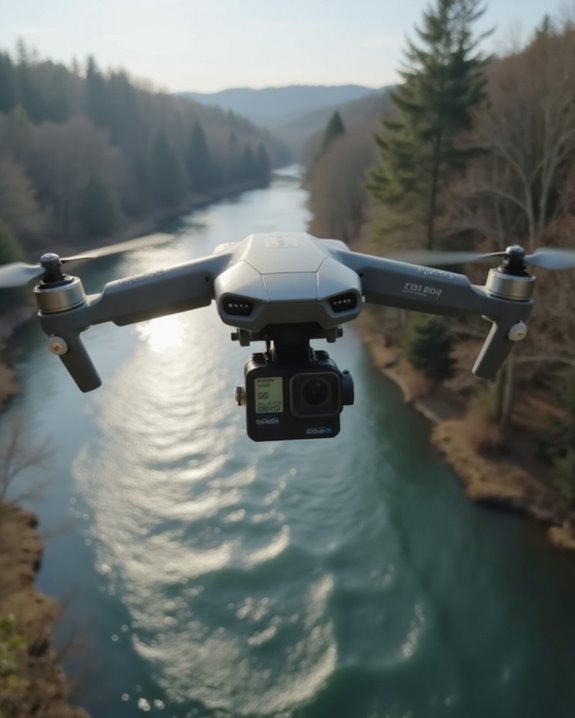
Beyond stabilization, capturing eye-popping FPV drone footage hinges on selecting the perfect resolution and frame rate combination! Modern GoPros offer incredible versatility, with resolution scaling options ranging from ultra-detailed 5.3K at 60fps down to 2.7K at a whopping 240fps for those butter-smooth slow-motion stunts.
The frame rate adjustment capabilities enable creative possibilities that simply weren’t available to drone pilots just a few years ago. Want cinematic flight footage? Try 4K60 for that perfect balance of detail and fluidity. Need to showcase that death-defying flip in slow-mo glory? Crank it up to 120fps! The Hero 11 Black’s innovative 8:7 sensor ratio even lets pilots capture footage that works across different social platforms without re-shooting—talk about efficiency for the modern content creator!
Battery Life and Recording Duration During FPV Flights
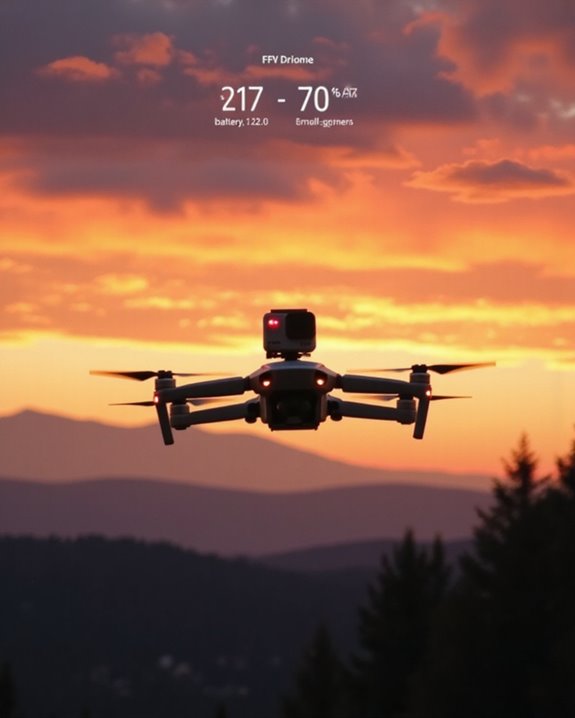
While capturing stunning aerial footage is exhilarating, pilots must carefully consider the delicate balance between battery life and recording duration when mounting a GoPro on their FPV drone. The addition of a GoPro greatly impacts flight time, with most setups achieving only 5-10 minutes of airtime before Battery Degradation becomes a concern.
Pilots face a vital decision: use the GoPro’s internal battery (adding weight but simplifying setup) or power it from the drone (reducing weight but requiring complex wiring). Voltage Monitoring becomes essential in either scenario, as dropping below safe levels can damage equipment mid-flight! Cold temperatures at higher altitudes further complicate matters, reducing efficiency of both drone and camera batteries. Smart pilots optimize their GoPro settings—lowering brightness, disabling WiFi, and reducing resolution when appropriate—to extend their precious recording time.
Mounting Solutions and Hardware for Secure GoPro Attachment
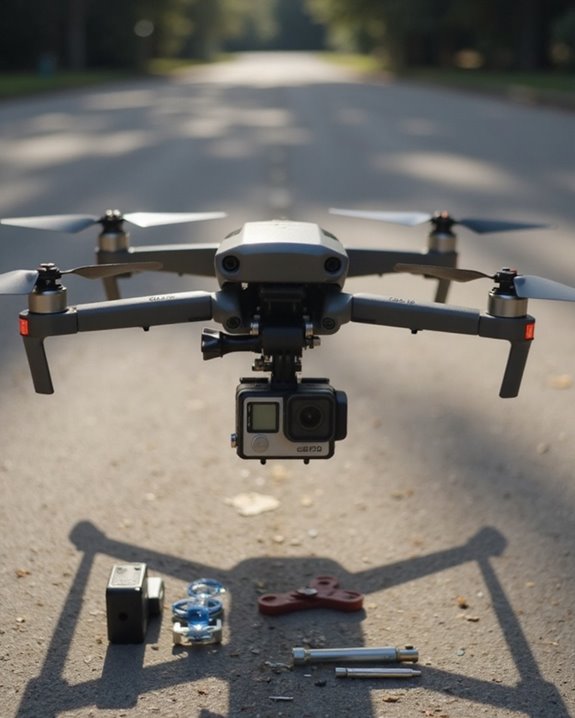
Secure mounting solutions represent the critical foundation of successful GoPro-to-drone integration, serving as the unsung heroes of breathtaking aerial footage. Whether using top mounts or rear configurations, pilots have numerous options that balance Vibration Control with Aesthetic Designs. GoPro compatibility comes standard with many FPV-specific products, giving creators flexibility without sacrificing stability!
Most mounting systems utilize lightweight materials and clever engineering to minimize added weight while maximizing durability. TANQ DJI O3 mounts and Aerial-Pixel options offer specialized features that eliminate propeller obstruction from your shots. For DIY enthusiasts, hot glue works wonders when applied carefully, though remember to protect your frame with tape first. When installing, always test your setup before taking flight – nothing ruins aerial cinematography faster than a mid-air camera separation!
Post-Processing Gopro FPV Footage With Specialized Software
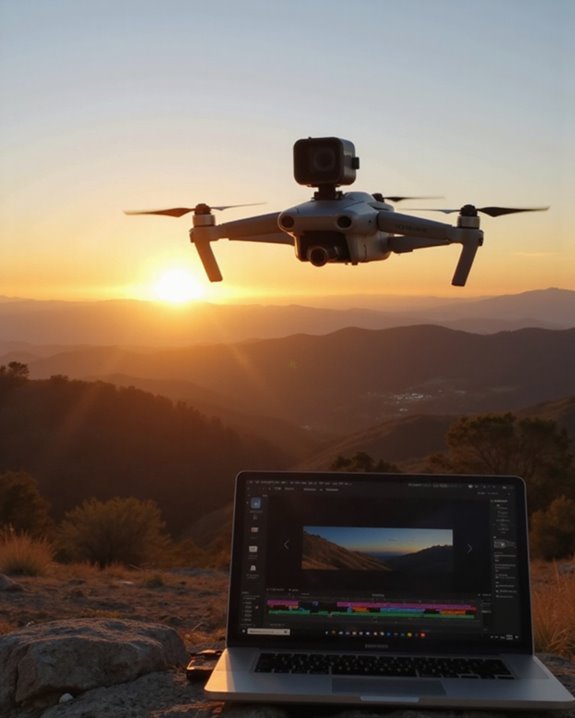
Post-processing transforms raw GoPro footage into cinematic masterpieces, elevating your aerial adventures from shaky recordings to professional-quality productions! Software options like Reelsteady GO harness GoPro’s gyro data to deliver buttery-smooth results, while budget-conscious pilots can turn to Gyroflow or Shotcut for decent stabilization without the price tag.
For truly polished videos, Color Grading makes all the difference, enhancing vibrancy and depth that showcase those breathtaking aerial landscapes. Don’t forget about Noise Reduction, especially for those high-frame-rate sunset flights! Most editors recommend disabling in-camera stabilization, as post-processing tools handle FPV’s wild movements much better. When exporting, HEVC format keeps quality high while keeping file sizes manageable—your social media followers will thank you!
Real-World Examples of GoPro FPV Drone Cinematography
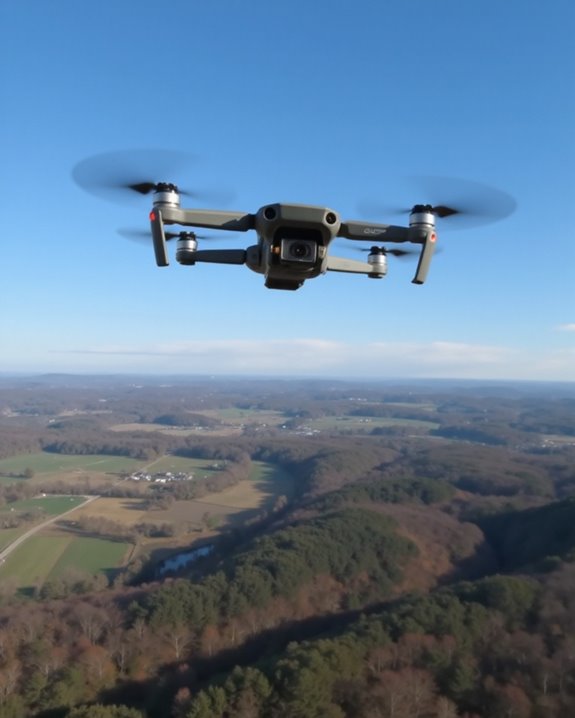
The breathtaking aerial shots seen in today’s most impressive FPV videos aren’t just happy accidents—they’re the result of skilled pilots pushing GoPro cameras to their cinematic limits! Professionals like Jay Christensen and Patrick Conroy demonstrate this mastery at events like the GoPro Mountain Games, where their race drones capture stunning footage that wows audiences.
Community Showcases often highlight how pilots blend technical prowess with artistic vision, adjusting frame rates and using ND filters to achieve that perfect cinematic look. From dawn patrol flights to heart-racing tracking shots through tight spaces, these Inspirational Videos prove GoPro’s versatility. The most compelling examples feature carefully planned flight paths and thoughtful camera settings—creating those “how did they do that?” moments that make viewers rewatch in amazement!
Frequently Asked Questions
Can Gopro Footage Be Livestreamed During FPV Flights?
GoPro footage can be livestreamed during flights via integration with FPV transmitters. Various livestream apps support this functionality, though signal latency must be minimized for effective pilot control and real-time visual feedback.
How Does Using a Gopro Affect Drone Flight Time?
GoPros greatly reduce drone flight time due to increased payload weight, creating additional battery impact. The camera’s power draw requires more energy from the drone, decreasing overall efficiency and operational duration during flights.
Are Gopro Mics Useful for Capturing FPV Flight Sounds?
Like a falcon with keen ears among the wind, GoPro mics offer reasonable sound fidelity for FPV flight sounds. Their mic quality surpasses standard FPV cameras, though wind noise remains challenging at high speeds.
Can Gopros Withstand Crashes Common in FPV Flying?
GoPros can withstand many FPV crashes but aren’t invincible. Crash testing shows they handle minor impacts well, while severe crashes may cause damage. Various repair options exist for damaged units if warranty doesn’t apply.
How Does Temperature Affect Gopro Performance During FPV Flights?
When the mercury drops, GoPro performance takes a hit. Cold ThermalEffects greatly reduce battery life and recording time. High AltitudeInfluence compounds these issues, requiring pilots to implement warming strategies between FPV flights.

